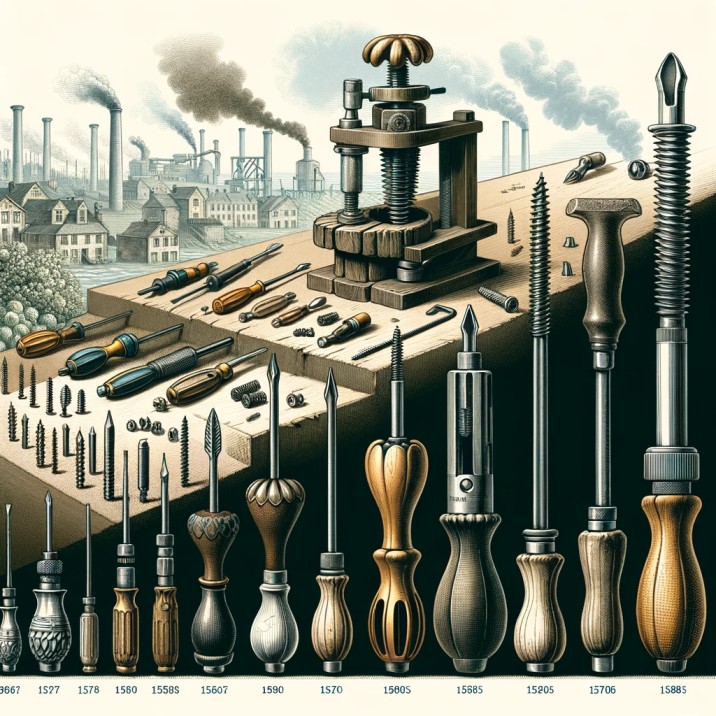The concept of the screw dates back to ancient times, believed to have been first conceptualized by Archytas of Tarentum around the 4th century BC. Archytas, often referred to as the father of mechanical engineering, is credited with developing the screw principle, but it was not until much later that screws and screwdrivers as we know them began to take shape.

The invention of the screwdriver, a tool that is now ubiquitous in almost every toolbox and household, has a fascinating history that intertwines with the development of the screw itself. While the exact origins of the screwdriver are shrouded in history, its evolution is deeply linked to the advancements in mechanical and industrial processes over centuries.
The earliest screws were used in presses – for wine and olive oil production – rather than as fasteners. These were large, wooden screws, and the tools used to turn them were more akin to bars or levers rather than screwdrivers. The metal screws that are more familiar to us began appearing in Europe during the 15th century. These early screws were handcrafted, and as such, were not standardized, leading to the creation of custom tools to fit individual screws – a precursor to the modern screwdriver.
The first documented use of the term “screwdriver” was in 1580 in France, referred to as “tournevis” (turnscrew). Early screwdrivers had pear-shaped handles and were made for slotted screws, the only type of screw head at the time. The simplicity of the design of slotted screws and their ease of manufacture contributed to their widespread use.
The Industrial Revolution in the 18th and 19th centuries was a crucial period for the screwdriver and screw. The need for standardization in industrial manufacturing led to the development of more uniform screws and subsequently, screwdrivers. The technological advancements during this period allowed for the mass production of screws with consistent sizes and threads, which in turn led to the standardization of screwdrivers.
One of the most significant developments in the history of the screwdriver came in the late 19th and early 20th centuries with the invention of different types of screw heads. The most notable was the Robertson screw, a square-socket screw invented by Canadian P.L. Robertson in 1908, and the Phillips head screw, invented by Henry F. Phillips in the 1930s. These designs allowed for more torque to be applied with the screwdriver and reduced the likelihood of the driver slipping out of the screw head, a common problem with traditional slotted screws.
The invention of power-driven screwdrivers in the 20th century further revolutionized the use of screws and screwdrivers. These electric and pneumatic tools allowed for faster and more efficient driving of screws, particularly in industrial settings. The development of cordless battery-powered screwdrivers made the tool even more accessible for everyday use in household and professional settings.
Over time, the screwdriver has evolved into various forms and sizes to accommodate a wide range of applications. From precision screwdrivers for delicate electronic work to large, heavy-duty models for construction, the versatility of the screwdriver has made it an essential tool in various fields.
In addition to the practical evolution of the screwdriver, its cultural impact is also noteworthy. The screwdriver has become a symbol of building, repair, and innovation. It is a tool that represents the ability to assemble, create, and maintain, which is integral to many aspects of life from simple home repairs to sophisticated engineering projects.
The history of the screwdriver also highlights the relationship between the development of tools and the advancement of technology. Each step in the evolution of the screwdriver reflects a response to changing needs and technological capabilities. This interdependence is a key aspect of the history of tools and machinery.
In conclusion, while the exact origin of the screwdriver is unknown, its development over centuries showcases the evolution of human ingenuity in tool-making. From a rudimentary tool crafted to fit individual screws to a highly versatile and essential component of modern toolkits, the screwdriver’s journey mirrors the broader story of technological progress and standardization. Its ongoing evolution and adaptation underscore the dynamic nature of tool development and its pivotal role in shaping both industry and everyday life.
To explore more about the historical development of tools and their impact on society, readers might be interested in delving into articles or resources on the history of technology or industrial design. Such resources would provide a broader context to the evolution of everyday tools like the screwdriver, illustrating how they have shaped, and been shaped by, human history and industry.


